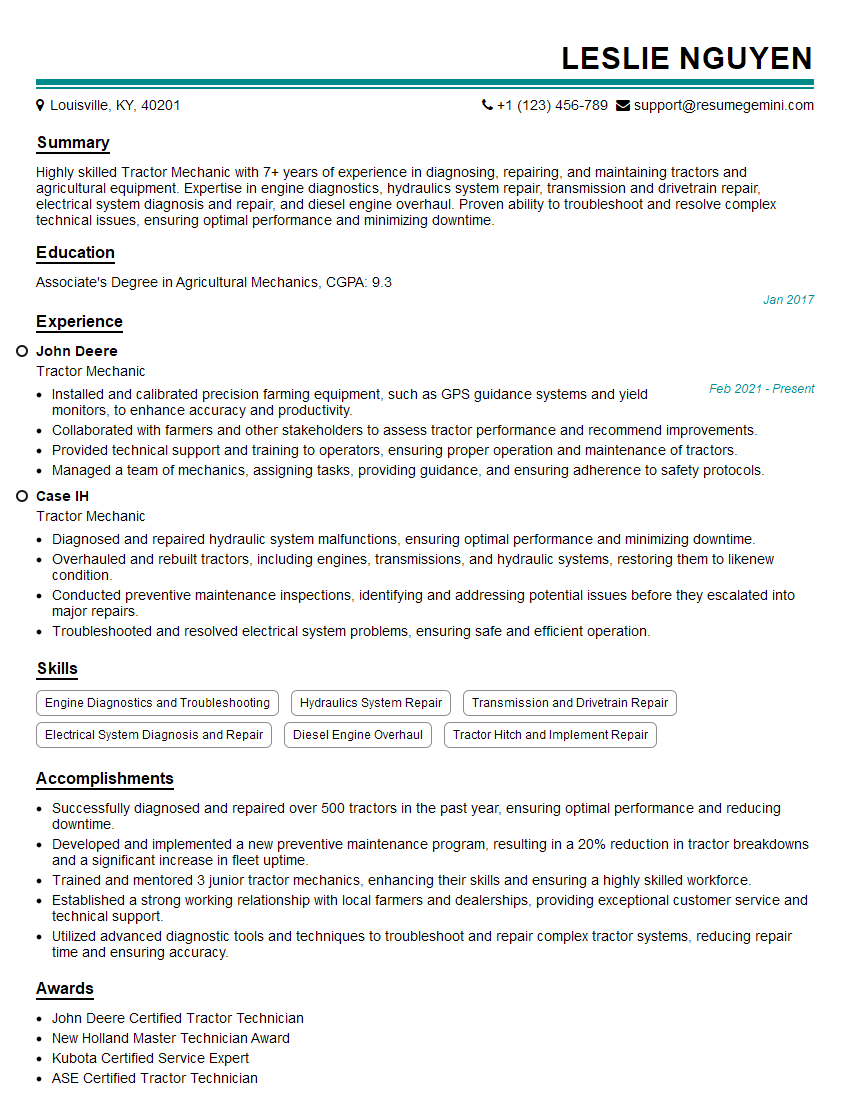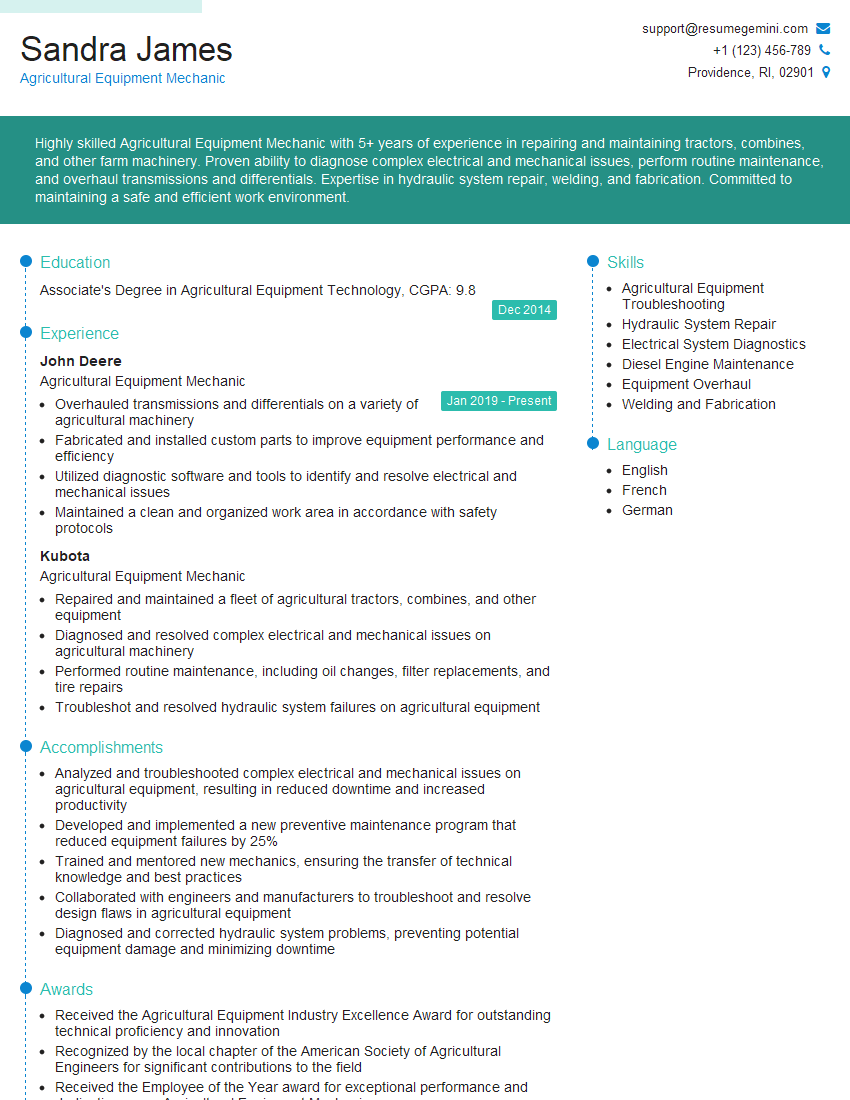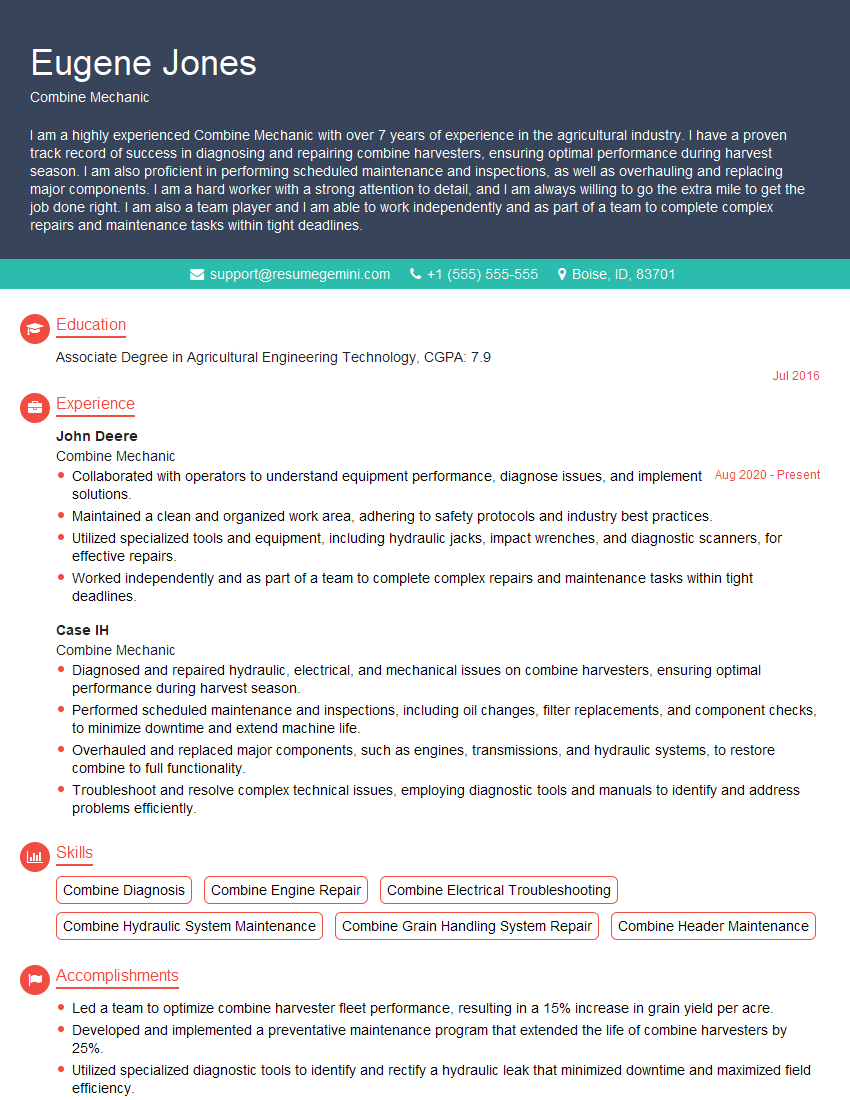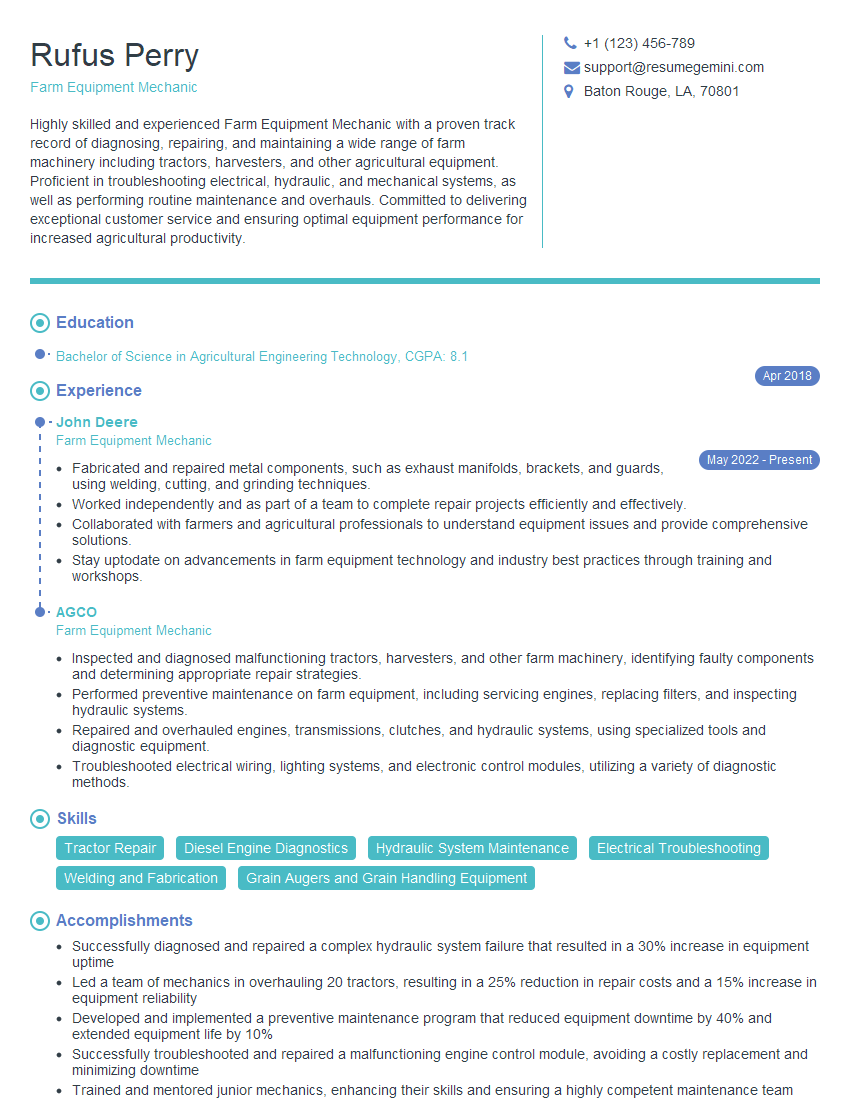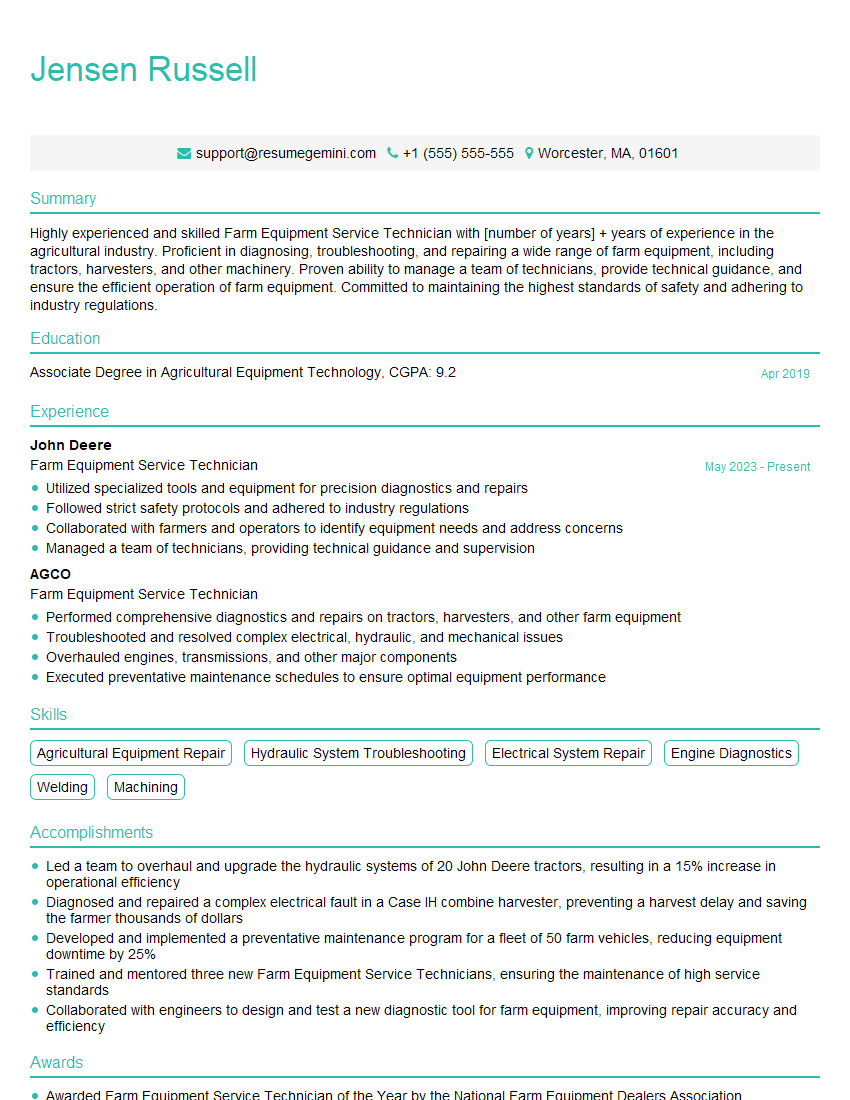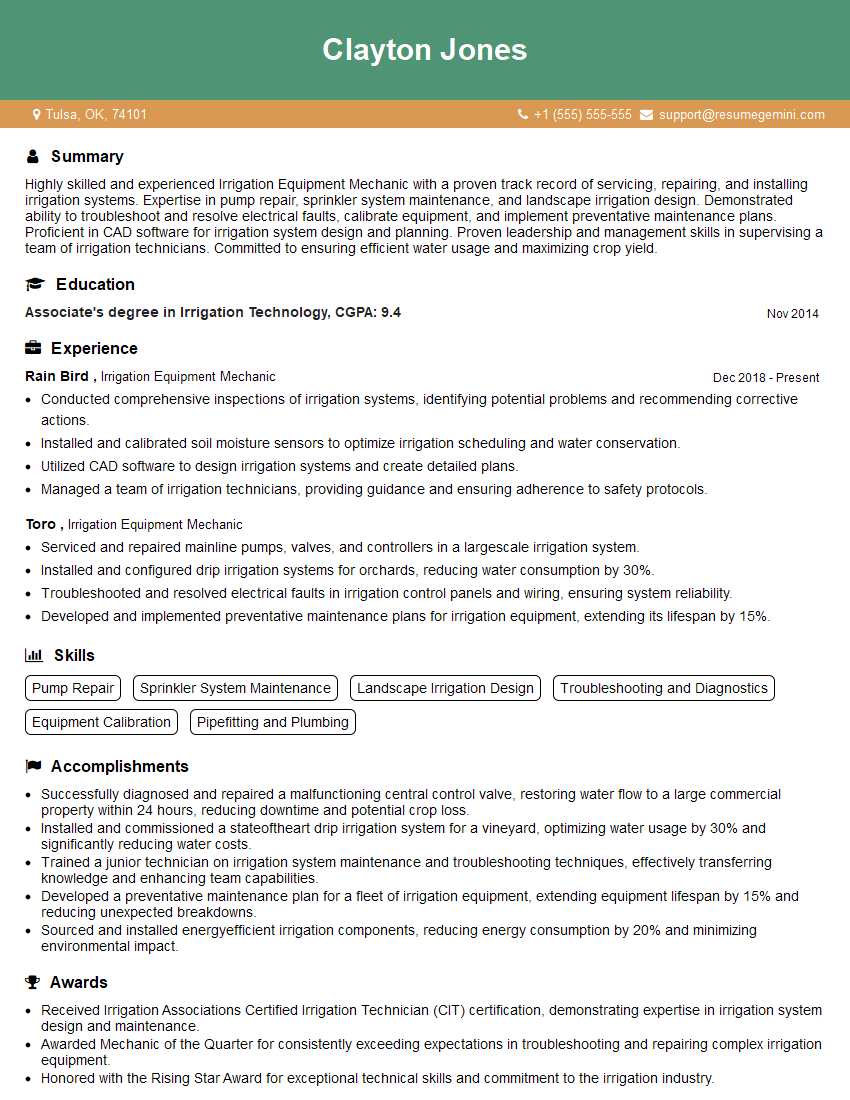Unlock your full potential by mastering the most common Farm Equipment Mechanics interview questions. This blog offers a deep dive into the critical topics, ensuring you’re not only prepared to answer but to excel. With these insights, you’ll approach your interview with clarity and confidence.
Questions Asked in Farm Equipment Mechanics Interview
Q 1. Describe your experience diagnosing and repairing tractor hydraulic systems.
Diagnosing and repairing tractor hydraulic systems requires a systematic approach. It begins with understanding the basics: hydraulic fluid acts as the power source, moving under pressure to actuate implements like loaders, three-point hitches, and power steering. Problems typically stem from leaks, pump failures, valve malfunctions, or filter blockages.
My process starts with a thorough visual inspection, checking hoses for leaks, looking for damaged components, and listening for unusual noises. I then use pressure gauges to measure fluid pressure at various points in the system, comparing readings to manufacturer specifications. This helps pinpoint the source of the problem – low pressure might indicate a pump issue, while inconsistent pressure could point to a faulty valve. For instance, I once diagnosed a slow-lifting loader by tracing a slow leak in a high-pressure hose using a specialized dye. Replacing that hose restored full functionality. If the problem isn’t visually obvious, I employ a troubleshooting chart specific to the tractor model, systematically eliminating possibilities. This might involve checking the hydraulic filter, testing the hydraulic pump’s output, or even disassembling control valves to inspect seals and internal components. I always prioritize safety, ensuring the system is depressurized before working on it.
Q 2. Explain the process of troubleshooting a malfunctioning combine harvester.
Troubleshooting a malfunctioning combine harvester is complex because it’s a highly integrated machine. The process is akin to detective work, systematically eliminating possibilities. I start by identifying the specific problem – is it related to cutting, threshing, separating, cleaning, or conveying? For example, if the combine isn’t cutting cleanly, I’d first check the cutter bar for obstructions, worn knives, or misalignment. Next, I’d inspect the reel and feeder for proper operation and adjust settings as necessary. If the problem is related to threshing, I’d check the cylinder speed and concavity settings. A clogged separator could point to a problem with the concave or sieves, requiring cleaning or adjustment.
My approach involves a combination of visual inspection, checking operating parameters, and listening for unusual sounds. I utilize diagnostic tools like pressure gauges, flow meters, and even infrared thermometers to pinpoint issues, such as a faulty bearing overheating or a blocked auger. Detailed operator logs can be incredibly helpful too. I once resolved a major threshing problem by tracing it back to a faulty drive belt, missed during a routine maintenance inspection. A malfunctioning combine is expensive downtime, so accurate diagnosis is crucial.
Q 3. How do you maintain and repair diesel engines in agricultural equipment?
Maintaining and repairing diesel engines in agricultural equipment requires a strong understanding of their inner workings. Regular maintenance is paramount, including oil changes, filter replacements (air, fuel, oil), and checking fluid levels. I emphasize the importance of using the correct lubricants and fuel, as these directly impact engine lifespan and efficiency.
Troubleshooting problems often starts with simple checks – checking the battery, verifying that fuel is reaching the injectors, and ensuring proper air intake. Engine malfunctions can be due to various reasons, including faulty fuel injectors, worn piston rings, or problems with the turbocharger. Using diagnostic tools, like compression testers and fuel pressure gauges, is critical in isolating the problem. For instance, low compression in a cylinder might indicate worn piston rings or a damaged head gasket. Repair procedures might involve replacing parts like injectors, gaskets, or even rebuilding the engine, depending on the severity of the damage. I always consult the manufacturer’s manuals and service literature for specific repair procedures and torque specifications. Safety is paramount; I never work on an engine while it’s running or without appropriate safety precautions.
Q 4. What are the common causes of planter malfunction and how would you address them?
Planter malfunctions often disrupt planting schedules, causing significant yield losses. Common causes range from simple issues to complex mechanical problems. Problems can be with seed metering, seed delivery, or fertilizer placement.
I approach troubleshooting systematically. First, I visually inspect the planter, checking for obstructions in the seed tubes, worn parts, or any signs of damage. Then I verify that the planter is properly calibrated for the seed type and spacing. I’ll check for proper seed flow, using a visual inspection of seeds flowing through the seed tubes and metering units. Issues with seed metering can stem from worn metering wheels, damaged seed plates, or blockages. Problems with fertilizer placement might be related to worn fertilizer disks or blockages in the fertilizer tubes. Often, simple adjustments or part replacements are sufficient to resolve these problems. For more complex issues, a detailed examination of the planter’s hydraulic and electrical systems might be required, using diagnostic tools to pinpoint the problem.
Q 5. Describe your experience working with precision agriculture technology.
My experience with precision agriculture technology is extensive. I’ve worked with GPS-guided systems for automated steering, variable-rate technology (VRT) for fertilizer and seed application, and yield monitoring sensors.
Integrating this technology requires a strong understanding of both the mechanical aspects of the equipment and the software controlling it. For example, I’ve helped farmers troubleshoot GPS signal issues, calibrate VRT systems, and integrate yield monitors with farm management software. My role involves ensuring the proper functioning of these systems – troubleshooting signal loss, making adjustments to ensure accurate application, and conducting regular calibration checks. Precision agriculture technology offers significant benefits in terms of efficiency and resource optimization, and resolving problems quickly keeps these benefits maximized. Working with these systems is continually evolving, as the technology becomes more sophisticated. Keeping up-to-date with the latest developments is a crucial aspect of my role.
Q 6. How familiar are you with different types of farm irrigation systems?
I’m familiar with a range of farm irrigation systems, including center pivot, linear move, drip, and sprinkler systems. Understanding their operation is essential for diagnosing malfunctions.
Center pivot systems require knowledge of pump operation, motor control, and the hydraulics that rotate the pivot. Linear move systems, often used in orchards, require understanding of the drive mechanisms. Drip irrigation demands knowledge of emitter placement, water pressure regulation, and the potential for clogging. Sprinkler systems rely on pump performance, nozzle selection, and uniformity of water distribution. Troubleshooting these systems involves checking water pressure, inspecting pumps and motors, assessing the condition of pipelines, and identifying potential leaks or blockages. Effective repair might involve replacing worn components, clearing blockages, and making adjustments to optimize water distribution. For more sophisticated systems with computerized controls, I have the experience to troubleshoot software and hardware issues.
Q 7. Explain the importance of regular maintenance schedules for farm equipment.
Regular maintenance schedules are critical for extending the lifespan of farm equipment, ensuring optimal performance, and minimizing downtime. These schedules vary depending on the type of equipment and its intensity of use.
A well-defined maintenance plan includes routine inspections – checking fluid levels, lubricating moving parts, tightening bolts, and inspecting belts and hoses. More comprehensive maintenance might involve replacing filters, servicing hydraulic systems, and performing engine tune-ups. Following manufacturer’s recommendations is key, as they provide guidelines for optimal maintenance intervals. Ignoring regular maintenance can lead to premature wear and tear, catastrophic failures, and costly repairs. It’s like servicing a car; regular oil changes and checks prevent major engine problems later on. A proactive maintenance approach significantly reduces the risk of unexpected breakdowns during critical periods like planting or harvest.
Q 8. How do you identify and resolve electrical issues in farm machinery?
Troubleshooting electrical issues in farm machinery requires a systematic approach. I start by visually inspecting wiring harnesses for any obvious damage like frayed wires, loose connections, or corrosion. A multimeter is my next tool; I’ll check voltage at various points in the circuit to pinpoint where the power is dropping off. This might involve testing the battery, fuses, switches, and the components themselves (solenoids, motors, etc.).
For example, if a tractor’s lights aren’t working, I might first check the fuse box. If the fuse is blown, I replace it and retest. If the problem persists, I’d move on to checking the wiring from the fuse to the light switch, then from the switch to the lights themselves, using my multimeter to trace the voltage at each point. If the problem is more complex, like a faulty alternator, I’d use a wiring diagram to help trace the complete circuit. I also utilize diagnostic software available on some newer machines for computerized diagnostics to find underlying issues which would be challenging to isolate manually.
Sometimes, the issue is as simple as a corroded terminal; a quick clean with a wire brush and dielectric grease can resolve the problem. Other times, it might require replacing a damaged component or even rerouting some wiring. Always remember to disconnect the battery’s negative terminal before starting any electrical work to prevent accidental shocks.
Q 9. What safety precautions do you take when working on farm equipment?
Safety is paramount when working on farm equipment. Before even touching a machine, I ensure it’s completely shut off and the power is disconnected. This includes the engine, PTO (Power Take-Off), and any hydraulic systems. I also engage the parking brake and chock the wheels to prevent accidental movement.
Personal Protective Equipment (PPE) is essential. This includes safety glasses or a face shield to protect against flying debris, gloves to protect my hands from cuts and abrasions, hearing protection to minimize noise exposure, and sturdy work boots to protect my feet. If working under the machine, I’ll use jack stands for support, never relying solely on a jack. I’m also aware of potential hazards like moving parts, hot surfaces, and chemicals. I always work in a well-ventilated area, especially when dealing with fuel or solvents.
Before beginning any repair, I carefully assess the task and anticipate any potential hazards. If I’m unsure about anything, I don’t hesitate to consult manuals, colleagues, or seek clarification. My priority is always to complete the job safely and effectively.
Q 10. Describe your experience with welding and fabrication in farm equipment repair.
I have extensive experience in welding and fabrication for farm equipment repair. I’m proficient with both MIG (Metal Inert Gas) and stick welding, using these techniques for repairing broken parts, fabricating custom components, and modifying existing equipment. I can weld various metals commonly found in farm machinery, such as steel, aluminum, and stainless steel.
For example, I’ve repaired broken cultivator shanks by cutting out the damaged section, fitting a replacement piece, and welding it securely back into place. I’ve also fabricated custom brackets and mounts for attaching additional equipment to tractors. Beyond welding, I possess skills in metal cutting (using plasma cutters, grinders, and saws), shaping, and finishing. My fabrication skills extend to working with sheet metal to create custom guards or repair damaged body panels.
Safety is always prioritized; I ensure adequate ventilation, use proper safety gear (including a welding helmet with the appropriate shade lens), and follow all safety regulations when operating welding equipment. Understanding the properties of the different metals and selecting the appropriate welding techniques and filler materials are crucial aspects of my work.
Q 11. How do you interpret and utilize repair manuals and schematics?
Repair manuals and schematics are indispensable tools. I use them to understand the workings of a system, locate specific components, diagnose faults, and perform repairs correctly. I start by identifying the specific model and serial number of the equipment to find the appropriate manual. I then systematically review the diagrams and text, focusing on the relevant sections pertaining to the problem.
Schematics provide visual representations of electrical and hydraulic systems, allowing me to trace wires, identify components, and understand how different parts interact. Repair manuals provide step-by-step instructions for common repairs and troubleshooting procedures. I interpret these documents meticulously, paying close attention to torque specifications, component part numbers, and safety precautions. For example, a schematic will show the wiring pathway for a tractor’s electrical system; this allows me to follow the circuit and pinpoint where a fault might be. The corresponding manual then helps me replace a faulty component or repair a broken wire correctly.
My proficiency in reading and interpreting these documents allows me to efficiently diagnose and repair issues, minimizing downtime and repair costs. I am confident in my ability to decipher complex diagrams and translate them into practical repair procedures.
Q 12. Explain your experience with different types of farm implements (e.g., plows, harrows).
My experience encompasses a wide range of farm implements. I’ve worked extensively on plows, both moldboard and chisel plows, understanding their adjustments for depth control and furrow width. I’m familiar with the intricacies of different plow shares and the importance of proper sharpening and maintenance. I’ve also worked with harrows, both disc and spring-tooth, understanding how their adjustments influence seedbed preparation and weed control. The maintenance and repair of harrows often involves replacing broken tines, adjusting the angle of the discs, and ensuring even weight distribution.
Beyond plows and harrows, I have experience with planters, cultivators, balers, mowers, and various other implements. This experience covers diagnosing mechanical and hydraulic problems, performing preventative maintenance, and making necessary repairs. This understanding extends to the various components within these implements, such as the mechanisms for seed metering, depth control, and proper row spacing in planters; I know how to recognize and address issues in those areas. This practical hands-on experience allows me to efficiently identify and rectify problems, ensuring the smooth and efficient operation of these vital tools.
Q 13. How do you handle emergency repairs in the field?
Emergency repairs in the field demand quick thinking and resourcefulness. My approach involves a rapid assessment of the situation. The first priority is always safety, securing the equipment and ensuring the safety of myself and others involved. I then perform a preliminary diagnosis to determine the severity and nature of the problem.
If it’s a minor issue, like a broken belt, I’ll utilize available tools and spare parts to effect a temporary fix to allow the operation to continue. More significant problems may require improvisation. I might use readily available materials to create temporary solutions until a more permanent fix can be implemented later. Good communication with the farm operator is key; I’ll explain the situation, the proposed fix, and the potential limitations of a temporary repair. For example, a broken hydraulic line in the field might necessitate a temporary clamp to contain the leak until a proper replacement can be installed. I’ll document the temporary repair to inform a later, proper repair. Clear communication ensures everyone involved understands the current status and plan of action.
Q 14. What are your troubleshooting methods for fuel system problems in tractors?
Troubleshooting fuel system problems in tractors involves a systematic process. I begin by visually inspecting the fuel tank, lines, and filters for any leaks or blockages. I then check the fuel level in the tank, ensuring there’s enough fuel to operate the engine. A low fuel level is often the simplest cause of engine failure. Next, I check the fuel filter. A clogged filter is a very common problem, restricting fuel flow. I’ll either clean or replace the filter as needed.
If the filter is clean, I move on to the fuel pump. I’ll check for proper operation of the fuel pump, assessing whether it’s delivering fuel at the right pressure. A faulty pump will need replacement. Next, I’ll inspect the fuel injectors or carburetor for proper operation. Checking fuel pressure using a gauge is critical. Low fuel pressure indicates a problem with the pump, filter, or fuel lines. If the problem persists, I might investigate the fuel tank vent; a blocked vent can create vacuum and prevent fuel from flowing properly. A clogged tank vent would be corrected, as would a faulty fuel shut-off valve.
Throughout this process, I use tools like pressure gauges, fuel line testers, and diagnostic tools, if available, to help identify the root cause of the problem. Understanding the tractor’s fuel system is fundamental, as fuel lines, pumps, and injectors can show various causes of engine issues.
Q 15. Describe your experience with engine diagnostics using computer systems.
Engine diagnostics using computer systems are crucial for modern farm equipment. These systems, often called Engine Control Units (ECUs), store vast amounts of data regarding engine performance. My experience encompasses using diagnostic software and scanners to interface with these ECUs, retrieving diagnostic trouble codes (DTCs). These codes pinpoint potential problems, ranging from a simple sensor malfunction to more complex issues like fuel injector problems or faulty wiring. For instance, I recently diagnosed a tractor with a P0340 code (camshaft position sensor circuit malfunction) by using a scan tool to read the code, then verifying the sensor’s output voltage and signal integrity. Following the manufacturer’s troubleshooting guide and using a multimeter, I was able to quickly replace the faulty sensor, restoring engine function.
Beyond reading DTCs, I can analyze real-time data like fuel injection pressure, engine RPM, and temperature. This helps in identifying intermittent issues that might not trigger a specific code. The ability to interpret these data streams is key to accurately diagnosing problems and preventing potential catastrophic engine failures. I’m proficient with both manufacturer-specific software and generic OBD-II scan tools, adapting my approach based on the specific equipment and its onboard diagnostic system.
Career Expert Tips:
- Ace those interviews! Prepare effectively by reviewing the Top 50 Most Common Interview Questions on ResumeGemini.
- Navigate your job search with confidence! Explore a wide range of Career Tips on ResumeGemini. Learn about common challenges and recommendations to overcome them.
- Craft the perfect resume! Master the Art of Resume Writing with ResumeGemini’s guide. Showcase your unique qualifications and achievements effectively.
- Don’t miss out on holiday savings! Build your dream resume with ResumeGemini’s ATS optimized templates.
Q 16. How familiar are you with different types of transmissions used in farm equipment?
Farm equipment utilizes a variety of transmissions, each with its own strengths and weaknesses. I’m highly familiar with manual transmissions, which are mechanically simple and reliable but require operator skill. These often employ gear selection through a lever and clutch operation. Then there are automated manual transmissions (AMTs), which automate the clutch operation and gear shifting, increasing efficiency and reducing operator fatigue. These still rely on gears, but the engagement and disengagement are controlled electronically. I’ve also worked extensively with continuously variable transmissions (CVTs), which use a belt and pulley system to offer infinite gear ratios. CVTs provide smooth power delivery and excellent fuel efficiency, especially in applications requiring constant speed changes like hay baling. Finally, I understand hydrostatic transmissions, common in smaller equipment, which use hydraulic fluid to transfer power. They provide exceptional control and maneuverability. My experience spans troubleshooting and repairing all these types, understanding the nuances of each system’s operation and maintenance requirements. For example, I recently repaired a CVT in a combine harvester involving belt adjustments and software calibration.
Q 17. What are the common causes of overheating in farm engines?
Overheating in farm engines can stem from several issues. A common culprit is a faulty cooling system. This could include a clogged radiator, a malfunctioning water pump failing to circulate coolant effectively, or a cracked radiator hose leading to coolant leaks. Another frequent cause is low coolant levels due to leaks or insufficient maintenance. Inadequate airflow around the radiator, often due to clogged debris, also contributes significantly. Problems with the engine itself such as a faulty thermostat (preventing proper coolant temperature regulation), head gasket failure (allowing coolant to mix with oil), or internal engine problems that generate excessive heat can also lead to overheating. In extreme cases, a seized water pump or fan failure is a serious concern. Think of the cooling system like a circulatory system for the engine. When any part is compromised, overheating can occur. Diagnosing overheating requires a systematic approach: check coolant levels, inspect hoses and the radiator for damage, check the thermostat and water pump function, and inspect the fan’s operation. I’ve often found that a seemingly minor leak or a clogged radiator can cause significant overheating, highlighting the importance of preventative maintenance.
Q 18. Explain your knowledge of different types of lubricants and their applications.
Different lubricants play vital roles in farm equipment maintenance. Engine oils are crucial for reducing friction, preventing wear, and cleaning internal engine components. The selection of engine oil depends on the engine’s specifications, including viscosity (e.g., 15W-40, 10W-30) and API rating (e.g., CJ-4, CH-4). Transmission fluids are designed to lubricate and cool the transmission components, ensuring smooth shifting and longevity. Hydraulic fluids transfer power and lubricate hydraulic systems in the equipment. They often require specific properties, such as high viscosity index and shear stability. Grease is used for lubricating bearings and other moving parts that need long-term lubrication with minimal leakage. Different greases have varying consistencies and properties based on their intended use, such as EP (Extreme Pressure) grease for high-load applications. Selecting the right lubricant is paramount. Using the wrong oil or grease can lead to premature wear and tear, equipment failure, and costly repairs. My experience includes understanding the different classifications, knowing how to select the appropriate lubricant based on equipment specifications, and recognizing signs of lubricant degradation, which could indicate further problems.
Q 19. How do you ensure the proper alignment of farm implements?
Proper alignment of farm implements is critical for optimal performance and to prevent damage to the equipment and the land. This process typically involves adjusting the hitch points and using leveling tools to ensure that the implement is correctly positioned relative to the tractor. Techniques vary depending on the implement. For example, aligning a plow involves adjusting the depth wheels and ensuring even furrow depth. A disc harrow requires adjustments to maintain even depth and overlap. A seeder needs precise calibration to guarantee even seed spacing and depth. This often involves using a laser level or plumb bob, measuring distances, and making fine adjustments to the hitch mechanism. Misalignment can result in uneven work quality, reduced efficiency, and unnecessary stress on the equipment, even potentially causing damage to components. I use various methods depending on the equipment’s features, like the three-point hitch’s adjustment capabilities, the presence of adjustable arms, or even simple measurement with a tape measure and levels.
Q 20. Describe your experience with preventative maintenance on balers and hay equipment.
Preventative maintenance on balers and hay equipment is crucial for ensuring efficient and safe operation during the busy haying season. My experience includes regular inspections of belts, chains, and bearings, checking for wear and tear. Lubrication is key; I check and replace grease in bearings and lubricate moving parts to avoid premature wear. I also examine the pickup teeth and bale chamber for any damage or obstructions. Blade sharpening is essential for proper cutting of hay. Proper tensioning of belts and chains prevents slippage and breakage, and I carefully inspect these components for wear. Cleaning the baler after each use is vital to prevent buildup of material, which can cause jams and damage. I also look for any signs of damage to the rollers, needles and twine mechanisms. I believe in meticulous record-keeping for tracking maintenance, and proactively replace parts before they fail unexpectedly, minimizing downtime during critical harvesting periods. For example, I’ve established a maintenance checklist to ensure nothing is overlooked.
Q 21. What are your strategies for managing multiple repair tasks simultaneously?
Managing multiple repair tasks simultaneously requires effective prioritization and organization. I use a task management system, often a combination of a physical whiteboard and a digital calendar. I prioritize tasks based on urgency and impact, focusing on repairs that are critical for ongoing operations first. This involves assessing the severity of each issue and its potential consequences. For example, a broken baler during harvest is far more urgent than a minor leak in a less-critical piece of equipment. I break down complex repairs into smaller, more manageable steps. This ensures efficiency and prevents feeling overwhelmed. I also allocate appropriate time for each task, considering the complexity and available resources. This approach keeps projects on track and prevents overruns. Effective communication with clients or farm managers is key. Regular updates on progress and anticipated completion times prevent misunderstandings and maintain transparency. I maintain a well-organized parts inventory, which helps ensure necessary components are readily available, minimizing delays. This proactive approach makes me efficient and reduces costly downtime.
Q 22. Explain your understanding of emissions regulations related to agricultural equipment.
Emissions regulations for agricultural equipment are increasingly stringent globally, aiming to reduce the environmental impact of farming. These regulations primarily target pollutants like particulate matter (PM), nitrogen oxides (NOx), and carbon monoxide (CO). Different regions have varying standards, often categorized by engine size and emission tiers (e.g., Tier 4 Final in the US and equivalent standards in the EU). Compliance is achieved through the use of advanced emission control technologies.
Tiered Standards: Regulations are phased in, with stricter limits introduced over time, pushing manufacturers to develop more sophisticated technologies.
Emission Control Technologies: Common technologies include Selective Catalytic Reduction (SCR) systems, Diesel Oxidation Catalysts (DOCs), Diesel Particulate Filters (DPFs), and Exhaust Gas Recirculation (EGR). These work in combination to reduce the harmful emissions released from the engine’s exhaust.
Periodic Inspections and Maintenance: Regular maintenance, including DPF cleaning and SCR fluid refills, is crucial for maintaining compliance and engine performance. Failure to adhere to these requirements can result in penalties and operational issues.
Example: A farmer operating a non-compliant tractor might face fines, and the tractor could be prohibited from operating in certain areas.
Q 23. How do you handle challenging or unfamiliar repair situations?
When faced with an unfamiliar repair, my approach is systematic and methodical. I begin by thoroughly assessing the problem, gathering as much information as possible. This includes examining the equipment for any obvious signs of damage, listening for unusual sounds, and checking any available diagnostic codes. I then consult technical manuals, online resources, and if necessary, reach out to experienced colleagues or the equipment manufacturer for assistance. My strategy involves breaking down the complex problem into smaller, manageable tasks, focusing on one issue at a time. For example, if a combine is experiencing harvesting issues, I would systematically check the header, the feeder house, the threshing mechanism, and the cleaning system to pinpoint the source of the problem, ensuring safety at each step.
I also prioritize safety throughout the process. Before any disassembly or repair, I ensure that the equipment is properly secured, power is disconnected, and appropriate safety equipment (gloves, eye protection, etc.) is worn. Thorough testing after the repair is crucial to ensure the problem is fully resolved and that the equipment is functioning correctly and safely.
Q 24. Describe your experience working with GPS-guided agricultural machinery.
I have extensive experience working with GPS-guided agricultural machinery, including tractors, planters, and sprayers. This involves both the practical application of the technology and its maintenance. My experience encompasses troubleshooting GPS signal issues, calibrating guidance systems, and working with various auto-steering systems. I understand the importance of accurate GPS data for optimal field operations, such as precise planting, efficient fertilizer application, and reduced overlap in spraying. I am familiar with different GPS correction signals (like WAAS, RTK, etc.), their accuracy levels, and their impact on machine operation.
For instance, I’ve worked on instances where a faulty GPS antenna caused inaccurate steering, leading to crop damage. By replacing the antenna and recalibrating the system, I resolved the issue, minimizing economic losses for the farmer. My experience extends to maintaining the integrity of the system’s hardware and software, ensuring optimal performance and data accuracy.
Q 25. How do you stay updated on the latest advancements in farm equipment technology?
Staying updated on advancements in farm equipment technology is crucial in this rapidly evolving field. I utilize various methods to achieve this:
Industry Publications and Trade Shows: I regularly read agricultural equipment magazines, attend industry conferences and trade shows to learn about the latest innovations and technological advancements.
Manufacturer Websites and Training: I actively check the websites of major farm equipment manufacturers for updates on their products and technologies, and I participate in manufacturer-provided training sessions to expand my knowledge.
Online Courses and Webinars: I leverage online resources such as educational websites and webinars to stay informed about cutting-edge technologies and best practices.
Networking with Colleagues: Discussions and collaborations with colleagues in the field help me learn about new technologies and troubleshoot challenges.
Q 26. Explain your experience working with different types of farm tires and their maintenance.
My experience encompasses working with various types of farm tires, including radial, bias-ply, and agricultural implement tires. Each type has its specific characteristics and maintenance requirements. Radial tires offer better fuel efficiency and ride quality, while bias-ply tires are more robust and puncture-resistant. I understand the importance of proper tire inflation pressure, as this impacts fuel consumption, traction, and tire lifespan. Underinflation leads to increased rolling resistance and premature wear, while overinflation increases the risk of punctures and uneven wear. I regularly inspect tires for cuts, wear patterns, and embedded objects.
For instance, I’ve addressed a situation where a tractor’s tires were significantly underinflated, leading to excessive fuel consumption. By correcting the inflation pressure and explaining the importance of regular checks to the farmer, I helped improve fuel efficiency and extend the life of the tires. Additionally, I’m familiar with tire repair techniques, including patching and plugging, and when a tire replacement is necessary.
Q 27. How do you ensure the safe storage and handling of hazardous materials used in farm equipment maintenance?
Safe storage and handling of hazardous materials used in farm equipment maintenance, such as oils, fuels, solvents, and batteries, are paramount. I adhere strictly to all relevant safety regulations and guidelines. This includes properly labeling containers, using designated storage areas with appropriate ventilation, and employing personal protective equipment (PPE) during handling. Spills are addressed immediately with appropriate absorbent materials and clean-up procedures to avoid environmental contamination and ensure worker safety. Disposal of hazardous materials follows all local and national regulations, using certified disposal facilities.
For example, I always utilize spill kits during fluid changes to contain any leaks, and I ensure used oil is collected in designated containers for recycling or proper disposal. I also conduct regular inspections of the storage areas to ensure compliance with safety regulations.
Q 28. Describe your experience with hydraulic component repair, including pumps and cylinders.
I possess significant experience repairing hydraulic components, including pumps and cylinders. My expertise includes diagnosing issues, disassembling components, replacing worn parts, and performing system pressure tests. I’m proficient in troubleshooting hydraulic leaks, identifying faulty seals and o-rings, and understanding the flow dynamics of hydraulic circuits. I’m familiar with various hydraulic pump types, such as gear pumps, vane pumps, and piston pumps, each with its own set of operational characteristics and failure modes.
One instance involved a malfunctioning hydraulic pump on a large combine harvester. After a thorough diagnosis, I determined the pump’s internal components were worn, resulting in a significant pressure drop. I successfully replaced the pump, ensured correct system pressure, and thoroughly tested the system before returning the harvester to service. In addition to repairing the mechanical aspects, I’m experienced in working with hydraulic schematics and system diagrams to trace fluid paths and locate pressure points.
Key Topics to Learn for Farm Equipment Mechanics Interview
- Engine Systems: Understanding internal combustion engines (diesel and gasoline), fuel systems, lubrication systems, cooling systems, and electrical systems. Practical application: Diagnosing engine performance issues and performing repairs.
- Hydraulic Systems: Knowledge of hydraulic pumps, valves, cylinders, and fluid power circuits. Practical application: Troubleshooting hydraulic leaks and malfunctions in tractors and harvesters.
- Transmission and Drivetrain: Familiarity with different types of transmissions (manual, automatic, CVT), axles, differentials, and drive shafts. Practical application: Repairing and maintaining drivetrain components to ensure efficient power transfer.
- Electrical Systems: Understanding wiring diagrams, sensors, actuators, and diagnostic tools. Practical application: Identifying and resolving electrical faults in farm equipment.
- Farm Implement Operation and Maintenance: Knowledge of various farm implements (plows, planters, harvesters) and their operating principles. Practical application: Performing preventative maintenance and repairs on a wide range of implements.
- Safety Procedures and Regulations: Understanding and adhering to safety protocols while working with heavy machinery and hazardous materials. Practical application: Demonstrating safe work practices and adhering to relevant regulations.
- Diagnostic Techniques: Proficiency in using diagnostic tools and interpreting fault codes. Practical application: Efficiently diagnosing and resolving complex equipment malfunctions.
- Welding and Fabrication: Basic skills in welding and metal fabrication for repairs and modifications. Practical application: Repairing damaged components and creating custom parts.
Next Steps
Mastering Farm Equipment Mechanics opens doors to a rewarding career with excellent growth potential. Demand for skilled mechanics is high, offering opportunities for specialization and advancement. To maximize your job prospects, creating a strong, ATS-friendly resume is crucial. ResumeGemini is a trusted resource to help you build a professional and impactful resume that highlights your skills and experience effectively. Examples of resumes tailored to Farm Equipment Mechanics are available to guide you. Invest time in crafting a compelling resume – it’s your first impression on potential employers.
Explore more articles
Users Rating of Our Blogs
Share Your Experience
We value your feedback! Please rate our content and share your thoughts (optional).
What Readers Say About Our Blog
Hi, I represent an SEO company that specialises in getting you AI citations and higher rankings on Google. I’d like to offer you a 100% free SEO audit for your website. Would you be interested?
good
